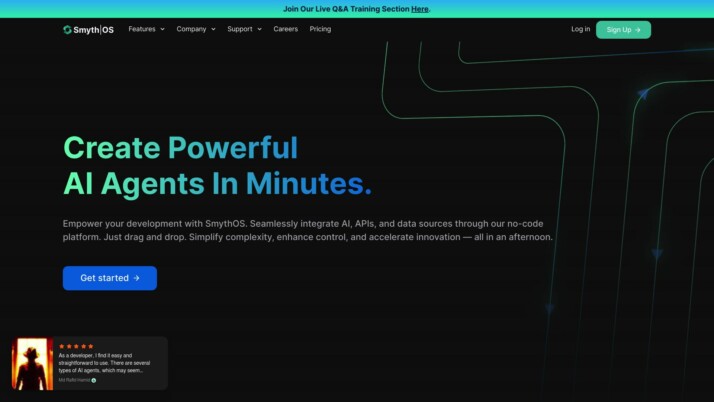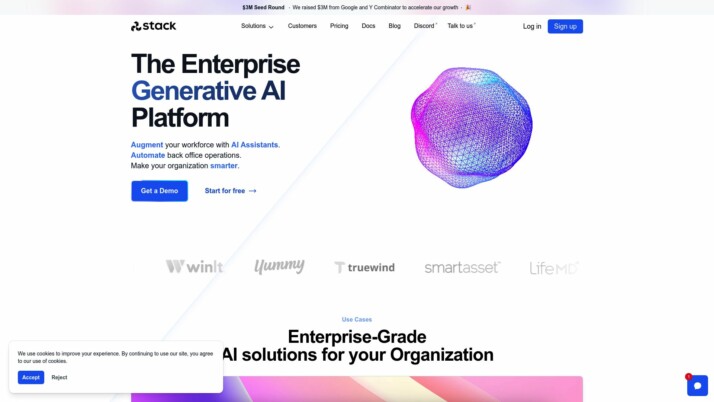In today’s rapidly evolving digital landscape, businesses are constantly seeking innovative solutions to streamline operations, enhance efficiency, and gain a competitive edge. The advent of AI has opened up a world of possibilities, empowering organizations to automate complex processes and harness the power of data-driven insights.
As the demand for AI-powered solutions continues to surge, platforms like SmythOS vs. Stack AI have emerged as industry leaders, offering sophisticated yet accessible tools for building and deploying AI agents.This comprehensive comparison delves into the unique features, capabilities, and use cases of these cutting-edge platforms, providing a valuable guide for decision-makers seeking to leverage the transformative potential of AI.
SmythOS Overview
SmythOS is a groundbreaking platform designed to streamline the creation and deployment of AI agents. Its unique features include a robust drag-and-drop interface, pre-built API integrations, and support for a vast array of AI models from different providers like OpenAI, Anthropic, and Hugging Face. Users can effortlessly design workflows that integrate with over 300,000+ popular apps and services, making advanced AI functionalities accessible and straightforward.


One of the standout features of SmythOS is its extensive integration ecosystem, which supports popular services like Slack, Trello, GitHub, and Stripe. This flexibility ensures that SmythOS can seamlessly integrate into virtually any workflow or business process. Additionally, the platform provides pre-configured connectors and templates for common tasks, significantly reducing setup time and allowing users to focus on innovation.
SmythOS can seamlessly integrate into virtually any workflow or business process.
Stack AI Overview
Stack AI is a commercial no-code platform that enables users to create, deploy, and manage AI-powered applications and workflows. It offers a user-friendly, drag-and-drop interface that democratizes access to advanced AI capabilities, making it accessible even to those without extensive coding expertise.
One of Stack AI’s key strengths lies in its enterprise-grade security features, ensuring compliance with standards such as SOC 2, HIPAA, and GDPR. This provides organizations with robust data protection and privacy guarantees when building and deploying their AI solutions.
The platform supports a wide range of use cases, from creating virtual assistants and chatbots to automating complex business processes. It allows for customizable deployments, either through API endpoints or interactive user interfaces, catering to diverse organizational needs.


Stack AI’s extensive integration capabilities enable seamless connectivity with various data sources and services, including Google Drive, Salesforce, Airtable, and Slack, among others. This flexibility empowers organizations to leverage their existing data and infrastructure when building AI solutions.
Feature Comparison
SmythOS and Stack AI share many similarities as commercial no-code platforms for building and deploying AI agents and applications. Both offer visual builders, support for various AI models and APIs, and the ability to deploy AI agents across various platforms such as websites, APIs, and chatbots.
However, SmythOS stands out with its extensive integration ecosystem, supporting popular services like Slack, Trello, GitHub, and Stripe out of the box. This broad connectivity allows SmythOS to seamlessly fit into virtually any existing workflow or business process. In contrast, Stack AI’s integrations seem more limited based on the provided information.
SmythOS’s broad connectivity allows it to seamlessly fit into virtually any existing workflow or business process.
Another key differentiator is SmythOS’s multi-agent orchestration capabilities. The platform supports the creation of multi-agent systems, enabling teams of AI agents to collaborate on complex tasks. This feature enhances efficiency and scalability, which could be a significant advantage for enterprises or organizations with intricate AI requirements. The information provided does not explicitly mention such multi-agent collaboration capabilities for Stack AI.
Additionally, SmythOS offers more versatile deployment options, including the ability to deploy agents as ChatGPT plugins or Alexa skills. This level of flexibility ensures that AI solutions built on SmythOS can be integrated into a wide range of existing systems and platforms. Stack AI’s deployment options, while extensive, do not appear to match the versatility of SmythOS in this regard.
Furthermore, SmythOS seems to have more robust data management and ingestion capabilities, including support for vector databases, sitemap crawlers, YouTube transcript crawlers, and various file formats like PDFs and Word documents. These features could be crucial for organizations dealing with large and diverse data sources.
| SmythOS | Stack AI | |
|---|---|---|
| CORE FEATURES | ||
| Hosted Agents | ✅ | ❌ |
| Explainability & Transparency | ✅ | ❌ |
| Autonomous Agents | ✅ | ❌ |
| Constrained Alignment | ✅ | ❌ |
| Sitemap Crawler | ✅ | ❌ |
| YouTube Transcript Crawler | ✅ | ❌ |
| Visual Builder | ✅ | ❌ |
| SECURITY | ||
| Constrained Alignment | ✅ | ❌ |
| IP Control | ✅ | ❌ |
| COMPONENTS | ||
| Huggingface AIs | ✅ | ❌ |
| DEPLOYMENT OPTIONS | ||
| Deploy as Scheduled Agent | ✅ | ❌ |
| DATA LAKE SUPPORT | ||
| Sitemap Crawler | ✅ | ❌ |
| YouTube Transcript Crawler | ✅ | ❌ |
Conclusion
SmythOS stands as a truly remarkable platform, empowering businesses and individuals to harness the full potential of AI with unprecedented speed and accessibility. By providing a comprehensive ecosystem of features and deployment options, SmythOS revolutionizes the way we create, deploy, and manage AI agents.
With its intuitive drag-and-drop interface, extensive integration capabilities, and support for a vast array of AI models and APIs, SmythOS democratizes advanced AI functionalities, making them accessible to users of all skill levels. From developers and technical teams to non-technical business professionals, SmythOS caters to a diverse range of users, enabling them to streamline workflows, automate processes, and drive innovation across various industries.
SmythOS revolutionizes the way we create, deploy, and manage AI agents.
One of SmythOS’s standout features is its multi-agent orchestration capabilities, allowing teams of AI agents to collaborate seamlessly on complex tasks. This not only enhances efficiency but also enables scalability, ensuring that your AI solutions can grow and evolve alongside your business needs.
SmythOS’s versatility extends to its deployment options, with the ability to deploy agents as APIs, chatbots, scheduled agents, and even as ChatGPT plugins or Alexa skills. This flexibility ensures that your AI solutions can seamlessly integrate into your existing systems and platforms, maximizing their impact and reach.
To experience the transformative power of SmythOS firsthand, explore our extensive range of agent templates and integrations. Get started with a free account and unlock the potential to automate, innovate, and drive business growth like never before. Don’t just take our word for it – check out the glowing testimonials from our satisfied customers who have experienced the SmythOS difference firsthand.